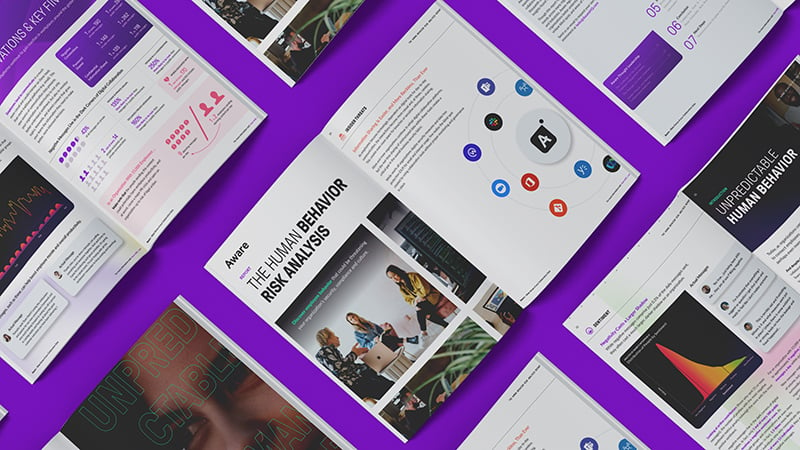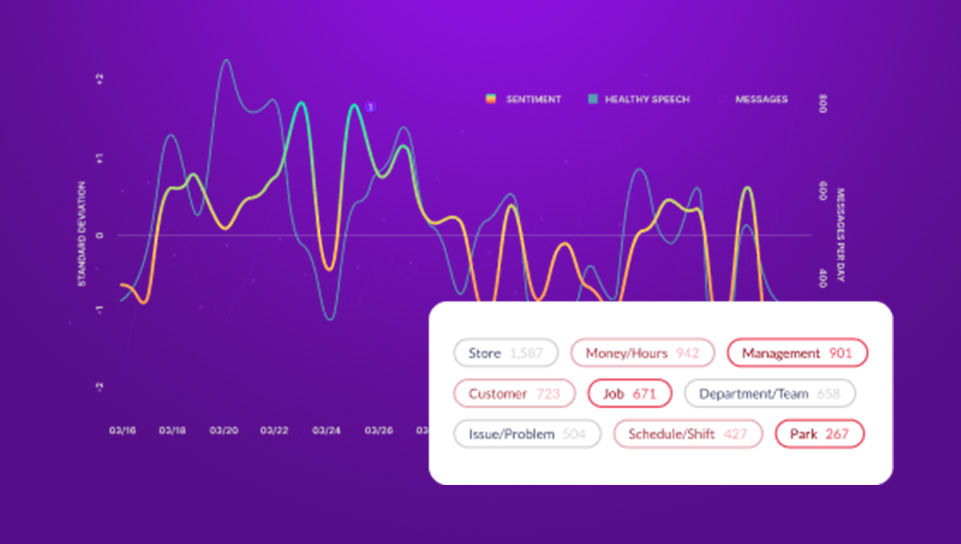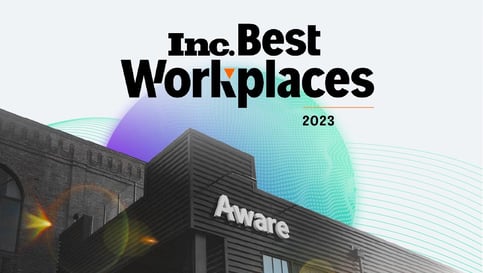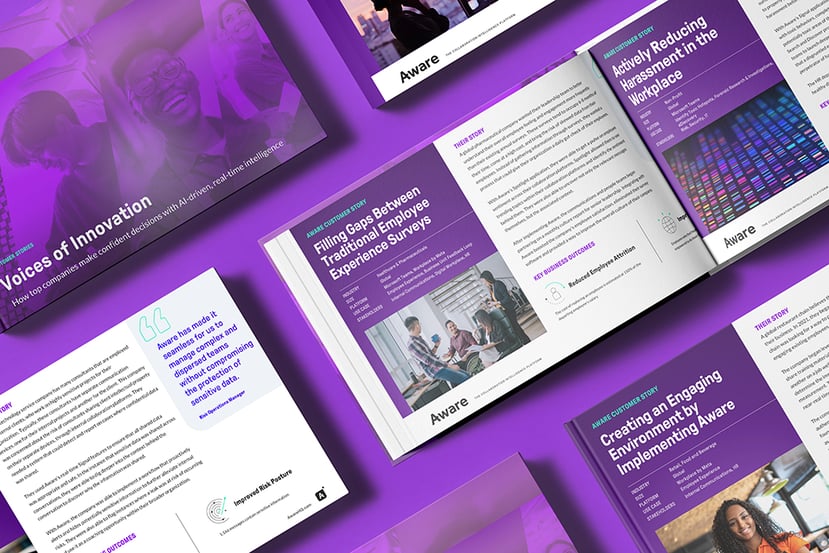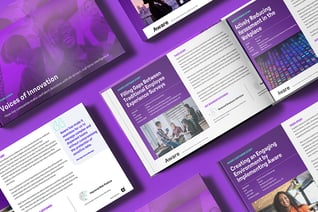Data Loss Prevention: A Comprehensive Guide
by Aware
DLP (data loss protection/prevention) is a cybersecurity solution companies use to detect and prevent data breaches. DLP strategies are intended to block the accidental or intentional unauthorized transfer or sharing of sensitive data outside an organization, thereby protecting entities from data leaks and loss.
What organizations use DLP?
Organizations, big and small, both public and private, use DLP strategies to safeguard their data. Some examples include:
- Healthcare organizations that protect PHI and must comply with HIPAA
- Financial institutions beholden to SEC and FINRA regulations
- Technology companies protecting against hacks and reputational harm
- Government agencies that hold classified information
- Educational institutions securing student records and research
Contents
- Why is DLP essential?
- DLP guide: The fundamentals of creating an effective strategy
- How do you decide if you need a DLP?
- What are the types of DLP?
- Breaking myths around DLP
- How Aware leverages AI to improve DLP
Why is DLP essential?
There are multiple reasons why businesses need controls in place to avoid data loss:
- To protect intellectual property and trade secrets. High-profile Slack cyberattacks against Uber, Electric Arts, and X (formerly Twitter) resulted in high costs to right their systems, falling stock prices, reputational harm, and damaged trust with users.
- To maintain regulatory compliance. When companies are dealing with protected health and financial information, data breaches come with much higher penalties. Meeting these strict data privacy and security regulations is crucial, not just to avoid costly fines and lawsuits, but to maintain a patient’s medical privacy or financial security.
- To detect anomalous or suspicious activity. DLP solutions use advanced technologies like AI and machine learning (ML) to quickly identify anomalous user activity or suspicious access patterns. DLP also automates these capabilities and responds swiftly with alerts to mitigate threats—both insider and external—prevent data leaks and block unauthorized activity.
- To expedite incident responses faster, streamlining tracking, and report on data movement through the organization’s ecosystem. Quickly isolating and containing affected data when an event occurs minimizes the potential damage and impact of any breach.
- To mitigate financial risks by catching potential data loss faster. DLP reduces the financial repercussions of regulatory fines, potential lawsuits, and reputational damage.
DLP guide: The fundamentals of creating an effective strategy
Failing to protect the data your company holds puts you at risk of regulatory violations, IP loss, potential lawsuits, and lost business. Following the fundamental strategies of DLP can help organizations remain compliant within their industries and mitigate risks of data theft or leakage.
Understand how information flows through the organization
Mapping how your data flows through your organization is one of the key ways to spot weaknesses in data protection where you are at increased risk of data loss. For instance, when you know how people share and access company-owned data, you can identify potential hotspots for shadow IT.
Identify and protect sensitive data
Along with knowing how data moves, you need to know what data is sensitive and should be protected. Applying accurate data classification to regulated data like personally identifiable information (PII), payment card industry data (PCI), protected health information (PHI), financial records, and intellectual property enables you to begin creating DLP solutions that comply with the appropriate regulatory bodies. Some data, like health records and credit cards, will require more stringent controls than other data, like email addresses.
Secure collaborative workspaces
Remote work and cloud-based collaboration tools have changed the ways employees interact with data, making DLP more critical than ever. Through monitoring and controlling data sharing in collaboration tools like Slack, Teams, and Zoom, organizations can mitigate the risks of unauthorized access, accidental exposure, and malicious actors.
Scan for malicious activity
Today’s hackers know the value of data within a company’s collaboration tools. Financial records, customer data, intellectual property—it’s all found in cloud-based repositories and tools where threat actors can find it. DLP solutions should incorporate advanced scanning capabilities to detect and stop potential threat activities like phishing and ransomware that can lead to data leakage.
Ensure regulatory compliance
Many companies are subject to a wide range of regulations, including HIPAA, HITRUST, GDPR, PCI-DSS, CCPA/CPRA, PIPEDA, and more. DLP plays a critical role in achieving and maintaining compliance with these regulations by having in place data protection measures and appropriate information security policies.
Continue guidance and employee training
DLP strategies need to be flexible and adaptable to keep up with data handling best practices and changing regulations. To do this, employees need to be kept up to date on changes to their industry and policies through ongoing education. Implementing employee training and awareness programs for DLP strategy helps organizations foster a culture of data security.
How do you decide if you need a DLP?
Answering a few key questions can help you determine if your organization can benefit from DLP strategies.
Do you handle sensitive data?
If your company handles or stores PII/PCI/PHI, or if you’re subject to regulations like PCI-DSS, GDPR, or HIPAA, then DLP is critical not only to securing that data but to proving you’re in compliance with the appropriate regulatory agencies.
Is your company's intellectual property valuable?
If the crux of your company’s business relies on intellectual property, such as research, source code, trade secrets, etc., then DLP solutions to protect those vital assets could be critical.
Do you have good data visibility?
With so much information flowing through the modern workplace, it’s critical to understand what information your company holds and where it resides. This supports informed decision-making about storage costs and solutions, reduces data sprawl, and ensures that your most valuable data is protected. DLP solutions can help you increase your visibility and map your data.
Are you vulnerable to insider threats?
Not all insider threats are malicious. The majority of insider risk incidents are caused by accident or negligence but can be just as damaging to a company as a hacker or malicious actor. Employees who lack proper training in information security, contractors who don’t understand your data landscape, those who circumvent the rules and introduce shadow IT systems, and people who make simple mistakes like uploading the wrong file to public channels, can all create vulnerabilities that expose your data.
Do you have remote workers or BYOD policies?
If your people work remotely on their own devices, DLP is even more essential. How do ensure your organization’s sensitive data is secure on a worker’s personal device? DLP solutions can help keep data protected.
Are you secure in your level of risk?
DLP strategies are designed to strengthen your risk posture and help you prevent data leaks and breaches. Are you confident that your current DLP controls are sufficient?
If any one of these questions applies to your organization, then DLP tools can help you implement better data visibility, stronger data protections, and more robust monitoring and risk mitigation while also supporting your employees with better data handling policies.
What are the types of DLP?
There are three major types of DLP, each of which is designed for the different ways organizations use and store data. They are:
Network DLP—monitors and controls incoming and outgoing data flowing through a network. Examples are email, file transfers, and web traffic. Benefits include:
- Comprehensive protection for data transmitted over the network
- Integration with other security technologies like firewalls and IDS/IPS
- Monitoring data moving across the entire network
Endpoint DLP—secures sensitive data on endpoints, such as desktops, laptops, and mobile devices. Software must be installed on each device to monitor user actions and enforce policies for unauthorized sharing prevention. Benefits include:
- Protects data even when stored or transmitted off-premises
- Provides detailed visibility into who’s accessing sensitive information and from where
- Secures data at the device level, essential for BYOD organizations
Cloud DLP—uses machine learning to automatically discover, classify, and protect sensitive data in cloud environments and on-premises systems. These solutions ensure data is not misused or accessed without authorization to the cloud. Benefits include:
- Designed purposefully to secure data in cloud environments
- Automates data discovery, classification, and protection within the cloud
- Maintains visibility and control over authorized users and cloud apps
- Offers data de-identification features like masking and tokenization
Each of these types of DLP has its focus specialty. Some organizations may benefit from deploying a combination of these DLP types for more comprehensive DLP management across their data ecosystem.
Breaking myths around DLP
Don’t fall foul of misconceptions about DLP. We debunk the top DLP myths to help you avoid misinformation.
Myth 1: DLP won't work in a virtual environment
Not true. There are many DLP strategies specifically designed to work seamlessly in virtual and cloud environments, offering visibility and control over data wherever it’s held.
Myth 2: You must have a DLP policy in place before implementing DLP software
Again, this is false. While a data handling and protection policy is definitely recommended, it’s not a requirement before deploying DLP software. The DLP solution itself can help organizations identify where new procedures may be needed, or if refinement is necessary.
Myth 3: DLP will slow my network
While this may have been true at one time, technology advancements have made it so today’s DLP solutions have minimal impact on network performance when properly configured to an organization’s infrastructure and policies.
Myth 4: DLP can be prohibitively expensive and require significant resources
This is another myth that may have been true at one time, but that newer options have made the DLP landscape more competitive. Managed security services and automated solutions have significantly reduced the operational overhead and associated costs of DLP implementation and management.
Myth 5: Benefits of DLP technologies are only realized after 12-18 months
This is another misconception. Today’s DLP solutions can bring value and measurable results within days or weeks when correctly employed. Many DLP software programs offer modular designs with the ability to start with high-value use cases.
The prevailing misconceptions of DLP often linger due to outdated perceptions of technology. Today’s DLP solutions are meant to be flexible, cost-effective, scalable, and capable of delivering swift value without high costs or impacts on performance.
How Aware leverages AI to improve DLP
With Aware, organizations can create comprehensive DLP strategies to encompass many collaboration tools, including Google, Microsoft Teams, Slack, Workplace from Meta, and more. Aware’s proprietary machine learning technology and AI models give businesses what they need to protect sensitive data from misuse or unauthorized access.
Aware can flag sensitive data in collaboration messaging platforms to mitigate the risk of data breaches and enable compliance with infosec best practices and regulatory requirements like FINRA, the SEC, and HIPAA. Your company can leverage AI with Aware to improve DLP with these features:
- Design rules that allow you to create flexible, custom policies to apply across collaboration platforms, users, channels, file types, images, and messages.
- The industry’s most accurate AI-powered detection, which reduces false positives using Aware’s proprietary ML models to detect images, code, passwords, screenshots, and PII with near-human accuracy.
- Automated actions that allow you to respond to incidents almost instantly. Real-time alerts notify team members, educate content authors, and hide or directly remove unauthorized or mishandled data from platforms.
- Context-rich alerts and reporting that give you the whole story to understand why a behavior happens. These insights into potential data exfiltration, insider threats, accidental blind spots, or shadow IT problems can help shape data handling policies and improve information security, regulatory compliance, and risk position.
- Multiple result export formats to integrate into your existing workflows, reducing interruptions to current processes and giving you a full picture of data movement.
- Enterprise-grade security features that include role-based access controls (RBAC) and message visibility controls to ensure access to data is compliant and handled as expected.
Contact us to learn how Aware can improve your organization’s risk posture and compliance readiness.
